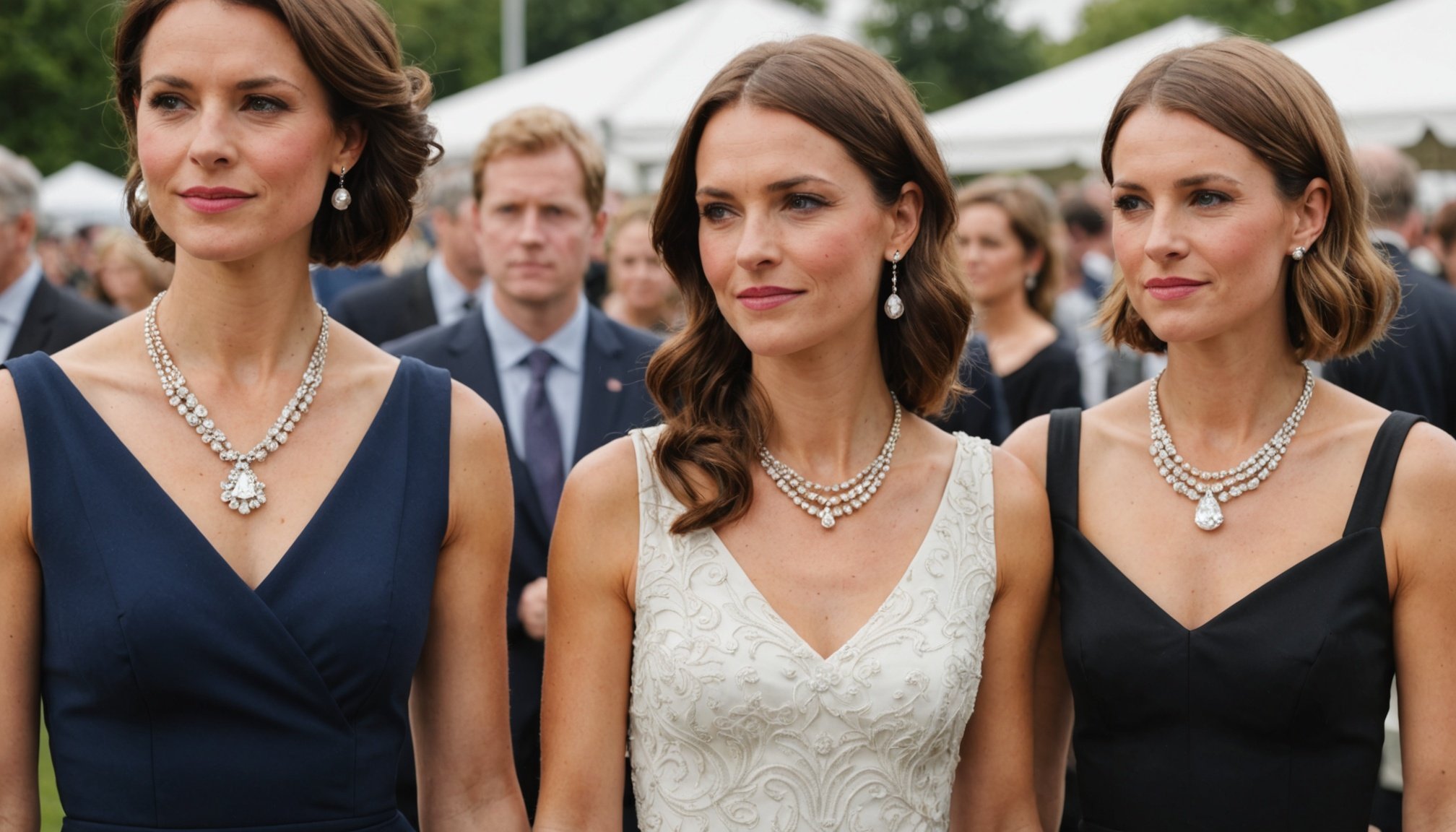Understanding Necklace Lengths
When it comes to necklace lengths, using a size guide is essential to find a flattering look. Standard necklace lengths typically range from choker to opera and are important to know when aiming for the perfect fit. Chokers are 14-16 inches, sitting snugly around the neck, while princess-length necklaces, at 17-19 inches, rest just below the collarbone. Meanwhile, opera necklaces reach around 28-34 inches, making a bold statement.
Measuring necklace length accurately is crucial for comfort and style. Begin by measuring your neck with a soft measuring tape. This ensures you select a length that complements both your neck size and your personal style preferences. It’s also worth considering the neckline of your outfit.
Topic to read : Discover the timeless elegance of women's oxfords & loafers
Necklace lengths impact the overall look and feel of an ensemble significantly. A choker can accentuate a slender neck, offering a sophisticated touch to off-shoulder tops. In contrast, a longer necklace can create an elongated silhouette, ideal for balancing high necklines. Knowing how different lengths interact with various outfits is key to crafting a cohesive appearance. Understanding these nuances aids in choosing jewelry that enhances both the outfit and the wearer.
Selecting the Right Style for Events
Choosing the perfect necklace styles for various events can elevate your ensemble significantly. Understanding the difference between styles suitable for formal events and casual gatherings is essential. At weddings or galas, an elegant, understated necklace complements gowns without overpowering the attire. Pearl strands or subtle pendant necklaces are examples that enhance formal wear.
Topic to read : The definitive handbook for selecting the perfect shawl to keep you cozy on uk coastal evenings
For casual gatherings and parties, embrace creativity and personal expression. Bold pieces with vibrant colours or intricate designs can add character to everyday outfits. Chunky chains or layered necklaces provide versatility and work well with informal attire, making you stand out beautifully.
When navigating UK fashion trends, consider the cultural influences and seasonal changes that can affect accessory choices. Necklaces popular in the UK often reflect both tradition and modernity, incorporating classic designs with a contemporary twist. The chic use of minimalist pendants or geometric shapes in necklaces showcases current stylistic preferences.
Ultimately, selecting necklaces is an art, influenced by the purpose of the event and current fashion trends. Remember to harmonise your necklace choice with the event’s nature and your personal style, ensuring your ensemble is both coordinated and compelling.
Visual Representation of Necklace Lengths
Visual aids are invaluable for understanding necklace lengths and styles. They simplify choosing the correct length by offering a clear comparison, making it easier to see how different lengths complement various necklines. Infographics, for example, can depict standard necklace sizes, like chokers and operas, and their positions on the neck. Such visuals enable a comprehensive grasp of the styling guide and aid individuals in selecting jewelry that enhances their ensemble.
Infographic on Necklace Lengths
An infographic illustrating necklace lengths can serve as a quick reference when shopping or styling outfits. It allows for immediate comparison between lengths, offering insight into their effect on outfit aesthetics.
Style Comparison Chart
A necklace comparison chart is also helpful, breaking down the elements of each style. This can include the typical occasions for each length and preferred necklines for pairing. Understanding these intricacies assists in making informed decisions about accessorizing.
Examples of Necklines and Necklace Pairings
Visual examples showing real-life outfits can highlight effective necklace use. Displaying how different styling guides match certain necklines can guide users in pairing the right necklace with their attire, ultimately enhancing their overall appearance.
Tips for Pairing Necklaces with Outfits
Pairing the perfect necklace with an outfit can elevate your look by adding harmony and balance. Here are some fashion tips to help coordinate your accessories with your attire.
Guidelines for Matching Necklaces to Various Necklines
Different necklines lend themselves to specific necklace types. For example, a v-neck top pairs beautifully with a pendant that mimics its shape, creating a cohesive visual line. On the other hand, strapless tops are perfect partners for chokers, which accentuate the neck and shoulder area. Boat necks or high collars benefit from statement necklaces, adding elements of drama and attention.
Balancing Your Outfit with Statement Versus Subtle Necklaces
When deciding between statement or simple pieces, consider the ensemble’s overall theme. A minimalist outfit might need a bold necklace to inject character. Conversely, elaborate ensembles are best complemented with delicate, understated jewelry to avoid visual overload. Subtle necklaces can enhance intricate patterns and textures without overwhelming them.
Cultural Considerations within UK Fashion Norms
In the UK, local style often balances between tradition and modernity. Understanding these cultural norms can be instrumental in accessory coordination. For instance, classic pearl strands might resonate well with the UK’s penchant for timeless elegance, while contemporary geometric necklaces reflect recent trends embraced by progressive communities.
Chokers vs. Long Necklaces
Chokers and long necklaces each bring unique styles, enhancing different looks and occasions. Chokers, typically tight-fitting around the neck, offer a classic and bold statement, suited especially for formal or edgy fashion. They complement off-shoulder or strapless outfits by highlighting the neck and collarbone, adding sophistication and elegance.
Long necklaces, usually 28 inches or more, differ fundamentally in their versatility. They’re perfect for layering, providing dynamic aesthetics by mixing lengths or adding pendants. Long necklaces excel at creating elongated lines, ideal for pairing with high neck tops or dresses, and can balance out busy patterns and textures.
Choosing between these necklace types depends on occasion and outfit. Situational guidelines can help; for a chic day-out look or minimalistic evening attire, a choker might shine. Conversely, long necklaces are excellent for less formal gatherings or when you desire to introduce an unexpected flair to your ensemble. Appreciating these styles’ distinctive qualities empowers you to tailor your accessory game accordingly, ensuring each piece not only aligns with your personal fashion but enhances it thoughtfully.
Accessorizing with Local Trends
Understanding UK fashion trends is essential when selecting necklaces that resonate with local styles and preferences. Current trends lean towards balancing tradition and innovation, often blending minimalist designs with bold accents. Influential designers frequently experiment with geometric elements, crafting pieces that offer modern flare while nodding to classic aesthetics.
Seasonal accessories also play a significant role in how fashion evolves throughout the year. During spring and summer, light and vibrant necklaces—like those with colourful beads or delicate chains—can uplift lighter fabrics and floral prints. In contrast, autumn and winter invite the use of heavier, more textured pieces. Consider chunky pendants and warming materials like metals and stones to accentuate the rich tones of colder seasons.
Leading designers and brands are pivotal in shaping local trends. Names like Victoria Beckham or Burberry set the tone with innovative collections that push boundaries while maintaining quintessential British chic. Their interpretations of necklace styles influence broader market tendencies, guiding both casual wear and formal attire. By keeping these trends in mind, one can effortlessly integrate contemporary flair into their accessories, ensuring both relevance and individuality.











